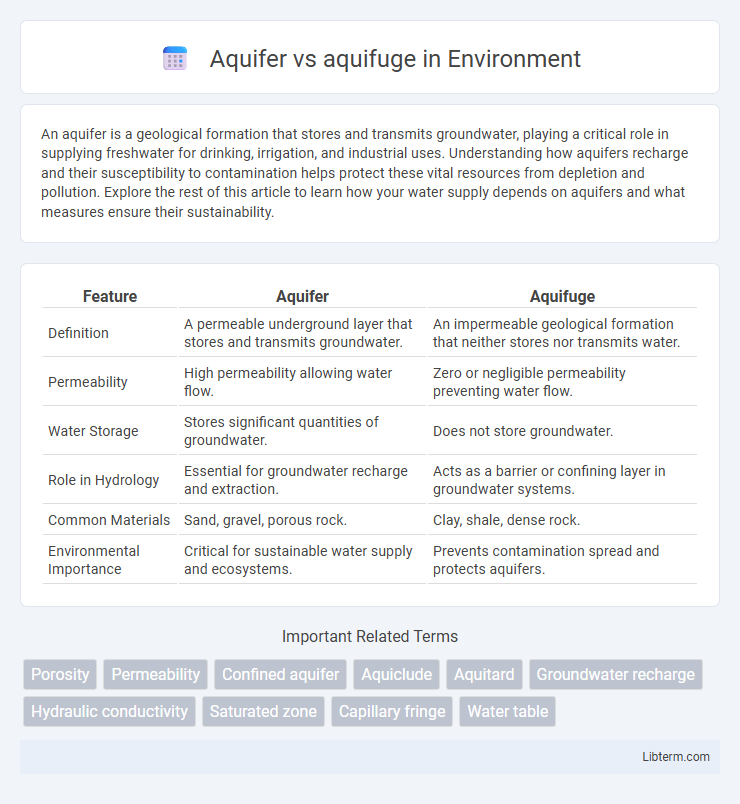An aquifer is a geological formation that stores and transmits groundwater, playing a critical role in supplying freshwater for drinking, irrigation, and industrial uses. Understanding how aquifers recharge and their susceptibility to contamination helps protect these vital resources from depletion and pollution. Explore the rest of this article to learn how your water supply depends on aquifers and what measures ensure their sustainability.
Table of Comparison
| Feature | Aquifer | Aquifuge |
|---|---|---|
| Definition | A permeable underground layer that stores and transmits groundwater. | An impermeable geological formation that neither stores nor transmits water. |
| Permeability | High permeability allowing water flow. | Zero or negligible permeability preventing water flow. |
| Water Storage | Stores significant quantities of groundwater. | Does not store groundwater. |
| Role in Hydrology | Essential for groundwater recharge and extraction. | Acts as a barrier or confining layer in groundwater systems. |
| Common Materials | Sand, gravel, porous rock. | Clay, shale, dense rock. |
| Environmental Importance | Critical for sustainable water supply and ecosystems. | Prevents contamination spread and protects aquifers. |
Introduction to Groundwater Reservoirs
Aquifers are porous geological formations that store and transmit groundwater, serving as critical reservoirs for water supply. In contrast, aquifuges are impermeable rock layers that hinder groundwater flow, acting as barriers within subsurface hydrology. Understanding the distinction between aquifers and aquifuges is essential for managing groundwater resources and designing effective water extraction systems.
What is an Aquifer?
An aquifer is a geological formation composed of permeable materials such as sand, gravel, or fractured rock that can store, transmit, and yield significant amounts of groundwater. It serves as a crucial natural reservoir, supplying water for agricultural irrigation, municipal consumption, and industrial uses. Unlike an aquifuge, which is impermeable and prevents water flow, an aquifer enables groundwater movement through its porous structure.
Characteristics of Aquifers
Aquifers are permeable underground layers of rock or sediment that store and transmit groundwater, characterized by high porosity and permeability, allowing water to flow through them efficiently. They vary in types, including confined aquifers, bounded by impermeable layers, and unconfined aquifers, exposed to surface water infiltration. Key characteristics include the ability to recharge from precipitation, sustain wells and springs, and maintain groundwater flow essential for ecosystems and human consumption.
What is an Aquifuge?
An aquifuge is a geological formation that does not transmit water, acting as an impermeable barrier to groundwater flow. Unlike an aquifer, which stores and conveys water through porous and permeable materials such as sand or gravel, an aquifuge consists of solid rock or dense clay layers that prevent water movement. Aquifuges play a crucial role in hydrogeology by confining aquifers and influencing the distribution and flow of groundwater in an area.
Key Properties of Aquifuges
Aquifuges are impermeable geological formations that prevent the flow of groundwater, contrasting with aquifers that store and transmit water. Key properties of aquifuges include extremely low porosity and permeability, making them effective barriers to water movement. Common examples of aquifuges are clay layers, shale, and unfractured crystalline rocks.
Major Differences between Aquifer and Aquifuge
Aquifers are permeable geological formations that store and transmit groundwater, whereas aquifuges are impermeable layers that neither store nor allow the flow of groundwater. The major difference lies in their porosity and permeability; aquifers have high porosity and permeability enabling water movement, while aquifuges have very low or negligible permeability, acting as barriers to water flow. This distinction critically affects groundwater availability and recharge, influencing water resource management and hydrogeological studies.
Importance of Aquifers in Water Supply
Aquifers serve as crucial underground reservoirs that store and transmit groundwater, directly supporting municipal, agricultural, and industrial water supply systems. Unlike aquifuges, which are impermeable layers that restrict water flow, aquifers enable natural replenishment and sustainable extraction of fresh water essential for human consumption and ecosystem health. Efficient management of aquifers helps prevent water scarcity and maintains the balance of surface water and groundwater resources.
Role of Aquifuges in Groundwater Protection
Aquifuges are impermeable geological formations that prevent the movement of groundwater, playing a crucial role in protecting aquifers from contamination by acting as natural barriers. By restricting the flow of water, aquifuges help maintain the purity of groundwater resources and control the lateral migration of pollutants. Their presence is essential in hydrogeological studies for effective groundwater management and contamination risk assessment.
Examples of Aquifers and Aquifuges
The Ogallala Aquifer in the central United States and the Guarani Aquifer in South America are prime examples of aquifers, characterized by permeable rock or sediment that stores and transmits groundwater. In contrast, aquifuges such as granite bedrock and clay layers act as impermeable barriers that prevent water flow and groundwater storage. These distinctions influence water availability and groundwater movement in hydrogeological studies and water resource management.
Conclusion: Aquifer vs Aquifuge in Groundwater Systems
Aquifers are permeable geological formations capable of storing and transmitting groundwater, making them vital for water supply and ecosystem sustainability. In contrast, aquifuges are impermeable or significantly low-permeability materials that prevent water movement, acting as barriers within groundwater systems. Understanding the distinction between aquifers and aquifuges is essential for effective groundwater management and hydrogeological assessments.
Aquifer Infographic

 libterm.com
libterm.com